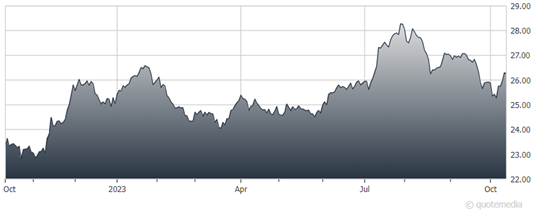I admire those of you following and investing in the 24 countries in the MSCI Emerging Market ETF (EEM). They will again offer outsized growth opportunities. But as the bull phase strengthens, risk capital will increasingly push the envelope to even higher risk-reward stock markets – often referred to as frontier markets. iShares Frontier and Select EM ETF (FM) is an efficient way to invest in them, says Carl Delfeld, editor of Cabot Explorer.
How big are these frontier markets? The top 26 countries that comprise the MSCI Frontier 100 index have a total population of more than 850 million. The remaining 75 have a combined population of about 800 million. In total, that’s roughly 25% of the world’s population.
iShares Frontier and Select EM ETF (FM)
These are countries that have less developed, less liquid stock markets, and normally smaller economies. Frontier markets are also completely off the radar screen of Wall Street analysts and financial pundits. But here are seven reasons for you to get ahead of the game by leapfrogging to frontier market growth:
1. Faster Economic Growth – Thirty-nine of the 45 countries projected to grow 6-7% over the next five years are frontier markets. A study by Everest Capital puts 17 of the 20 fastest-growing economies in the world in the frontier camp.
2. Favorable Demographics – A young population means lower financial burdens for government and a dynamic consumer class catching up to the West. About 40% of the world’s 15-to-24-year-olds live in frontier countries, versus less than 10% in North America, Japan, and Europe.
3. Low Debt – The government debt in these markets averages around 45% of GDP – half that of developed countries.
4. Integration with the Global Economy – Due to breakthroughs in communications and rising demand from multinationals for low-cost labor, resources and new consumer markets, frontier economies have gone from being out of the loop to smack in the middle of it.
5. Attractive Market Valuations – Because listed frontier market companies remain hidden to many investors, bargains abound. Frontier markets account for 25% of the world’s population and 12% of the global economy but less than 3% of the market value of all companies trading on world stock markets. This gap will eventually close.
6. Inefficient Markets – While this cuts both ways, one could argue that because frontier markets are small and less liquid, high-quality companies sometimes can be picked up at bargain prices by alert investors.
For example, fueled by Mongolia’s globally significant copper and gold deposits, investors bid up Mongolia’s stock market 900% in dollar terms from its 2009 low to its 2011 high. Over the next nine years, that market traded 69% lower before surging 130% in 2021.
7. Low Correlation to Other Markets – Blending in some frontier stocks to your portfolio will actually lower your portfolio risk and volatility since these markets tend to march to the beat of a different drum. When developed or emerging markets head south, frontier market stocks can go the other way—their fates are not intertwined with the more developed markets.
These markets are not for the faint-hearted, but adding even a little exposure could add some high-reward punch to your portfolio.
Recommended Action: Buy FM.




















